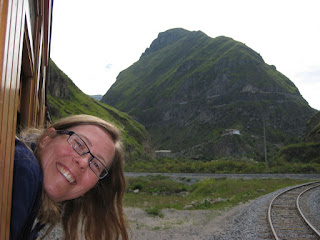We have very little to report today. This is due to our desire to get to Alausi for the infamous train ride. The 4.5hr trip saw us change buses in Riobamba, quite a large city by Ecuador standards. From what we saw of the city, it didn't look like we were missing much. The most remarkable part of the journey was again the amazing scenery surrounding us on our travels. That and Emma having a lady's shopping resting on her head for 20 minutes. The indigenous people here carry loads on their backs in big scarves and it was one particular load that was on Emma's head. This was obviously a bus on the school run so with all the kids plus a few extras, there was barely enough standing room.
 |
| Alausi and hills. |
 |
| The train station. |
For the second time, we didn't have accommodation booked and a handy tip by the man at the station saw us stay at the La Posada del Tren. A good recommendation.
 |
| Emma and St Peter. |
In the evening there was a procession through the town of the local amateur sports teams (police, local govt, etc). Once over the town basically shut down, at 8:30pm. Not the place for a late night out! Despite this, it's a lovely little town with beautiful surroundings so we were very happy to be staying here.
Saturday 12th March 2011
 |
| Our train, built in France. |
 |
| Emma and the Devils nose. |
 |
| Sibambe station and paths leading to Cuenca and Guayaquil. |
Back in town we were lucky enough to jump straight on a bus to Cuenca, our penultimate stop in Ecuador. Our friendly bus driver even held the bus and pulled it up outside our hostel so we could grab our bags. We're pretty certain this wouldn't happen in the UK!
Not much to report from our first night in Cuenca other than some rather tasty 2 for 1 cocktails and time spent getting our bearings around a new city.
 |
| That train track is also ours! |
No comments:
Post a Comment